2015-06-27
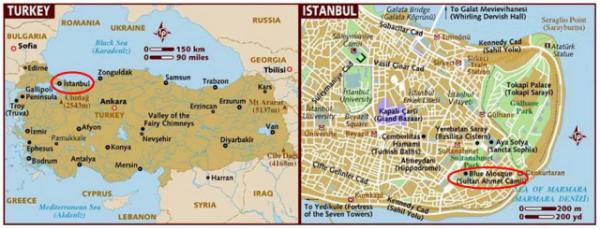
【Aiden in English】
Turkey's mosques are vast and spectacular. There is an excellent variety of them in Istanbul, where Muslims worship and pray. The Blue Mosque, or Sultanahmet Camii in Turkish, has become one of the most exquisite examples of architecture since it was built in the early 17th century and remains unique worldwide. If you haven't noticed, the Blue Mosque is blue, hence the name. The shade of color is derived from the blue and green Iznik tiles throughout the mosque. The fact that the Blue Mosque neighbors the Hagia Sophia makes it hard to mask, too. The history behind this Muslim house seemed as long and full as the line waiting to enter it. The mosque was built by the Islamic people, while some mosques used to be Christian or Orthodox churches, like the Hagia Sophia. When the religion shifted to Islam in this area, the Muslims tweaked a few things in the churches, and bam! They became mosques afterward. However, the Blue Mosque was initially built for Islam and featured six minarets, small towers that protruded from the structure at the corners or empty areas. Yet, what made the sight fantastic was an accident. The Sultan told the architect to build either an altar or a gold minaret, but "gold" in Turkish sounded remarkably close to "No. 6" or "alti." Therefore, we have an extraordinary mosque today instead of a gold tower that would probably be melted down and sold. A large dome, covered with six minarets, stands atop 12 arches, supported by four broad and strong marble pillars. Unlike the Hagia Sophia, the floor of the Blue Mosque is covered with a red carpet. Shoes must be removed, and shoulders, knees, and women's heads must be covered. As its name suggests, the blue color seemed more drastic and spread over the walls and ceilings. The contrast made other colors brighter and more distinct than the dull gold in the Hagia Sophia. The Blue Mosque is still active in service. On Fridays, tourists are not allowed to enter until after 2 p.m. The Islamic followers prayed five times: early morning, noon, afternoon, evening, and late evening. They faced the holiest city of Mecca, the center of the Muslims. The Islamic religion is one of a kind; sometimes, that's what life needs: a little "one of a kind." 【红霞译】
土耳其的清真寺巍伟壮观,伊斯坦布尔“进城”有着许许多多这样为穆斯林人提供念经祷告的地方,十七世纪初期修造的蓝色清真寺就是其中最为精美的建筑典范,堪称天下无双。 的确,蓝色清真寺带有蓝色,不妨提醒一句,它的名字由此而来。蓝色源于土耳其伊兹尼克“胜利”蓝绿色瓷砖贴面,加上又与圣索菲亚“智慧”大教堂为邻,一眼就能认出它来。
蓝色清真寺历史悠久,全部由穆斯林人一手建成,而城里有些伊斯兰教堂从前不是基督教堂就是东正教堂,譬如圣索菲亚大教堂。既然伊斯兰教主导宗教信仰,穆斯林人便统统将原有教堂改头换面,啪唧!一下子变成了清真寺。然而,蓝色清真寺却独树一帜,从头到尾都是原装,六根宣礼塔即小型尖塔傲然屹立在建筑物上空,如此奇观景致其实并非设计本意,当初苏丹王要求建筑师加盖一个黄金宣礼塔,但“黄金”在土耳其语中与号码“六”发音相似,结果黄金塔化成泡影,取而代之的是眼前这个了不起的建筑,巨型圆顶连同六根尖塔建在十二个拱门之上,四根又粗又壮的大理石柱支撑整个结构。
不像圣索菲亚大教堂,蓝色清真寺的地面全部铺上红地毯,所有人一律要脱掉鞋子,肩膀不能外露,裙子裤子非得长过膝盖,女人头盖必须包得严严实实。与其名称遥相呼应的是,蓝色主导一切,墙面屋顶无处不在,反倒将其它色彩衬托得比圣索菲亚大教堂死气沉沉的金黄色更加鲜艳明快。 蓝色清真寺至今仍用于宗教活动,每个星期五在下午两点之前游客不得入内。穆斯林教徒每天祈祷五次:早晨、中午、下午、傍晚和入睡前,他们面朝圣城麦加,即穆斯林信仰的核心。由此说来,伊斯兰教确实与众不同,不过有时生活本应多元化。 Today in History(历史上的今天):
2015: Istanbul, Topkapi Palace of Turkey(土耳其伊斯坦布尔·炮门皇宫) 2015: Istanbul, the Basilica Cistern TUR(土耳其伊斯坦布尔·地下水宮)
2014: YMCA Camp—Video Games(基督教青年会营视频游戏) 2013: 雅虎箱被盗(YHOO Email Hacked) 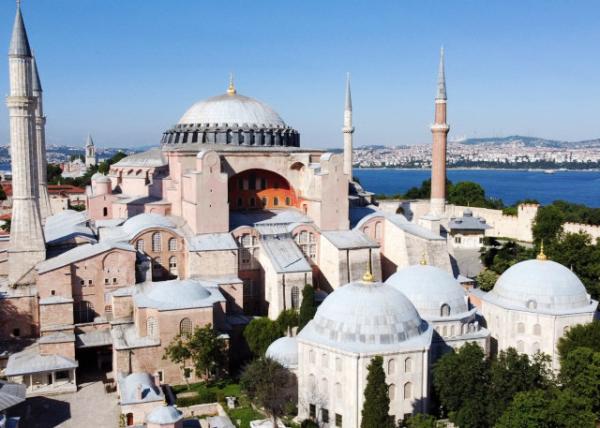 Overlook of Sultan Ahmed Mosque Overlook of Sultan Ahmed Mosque
(鸟瞰蓝色清真寺) 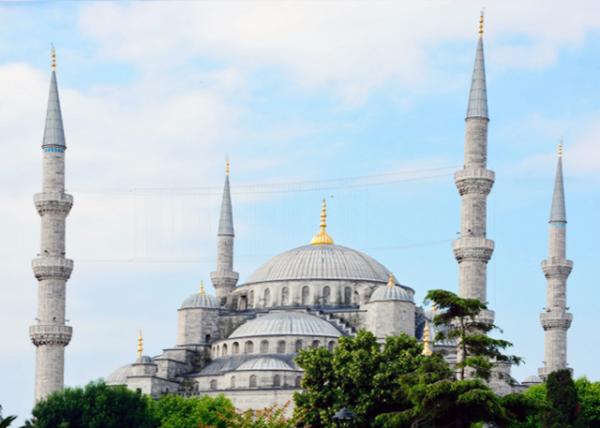 Cupola Dome, Semi-Dome & Apse Cupola Dome, Semi-Dome & Apse
(冲天炉圆顶半圆顶与后殿) 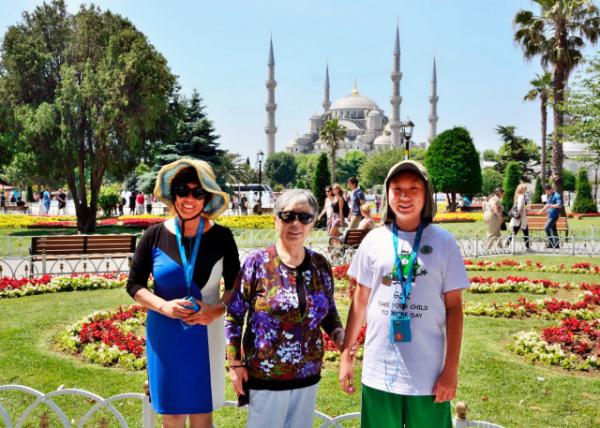 Sultan Ahmed Mosque (蓝色清真寺 06-26-2015) Sultan Ahmed Mosque (蓝色清真寺 06-26-2015)
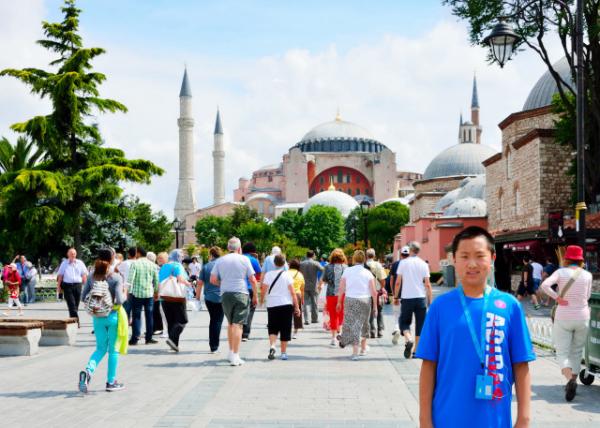 On the Way to Blue Mosque from Hagia Sophia On the Way to Blue Mosque from Hagia Sophia
(圣索非亚大教堂·去蓝色清真寺的路上 06-27-2015) 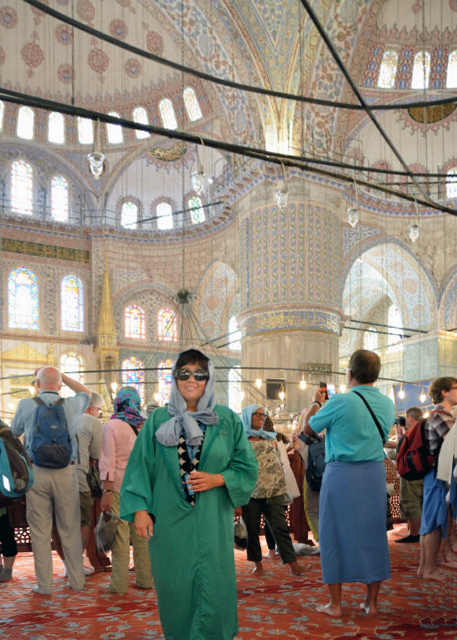
No Shoes w/ Shoulders, Knees, Women's Heads Covered (脱鞋光脚、肩膀不能外露、裙裤过膝、女人包头 06-27-2015) 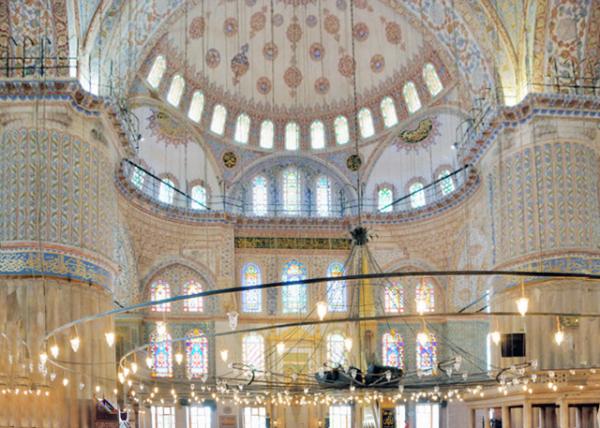 > 200 Stained Glass Windows w/ Intricate Designs Admitting Natural Light Assisted by Chandeliers > 200 Stained Glass Windows w/ Intricate Designs Admitting Natural Light Assisted by Chandeliers
(复杂设计的200多个彩色玻璃窗自然采光及枝形吊灯照明)
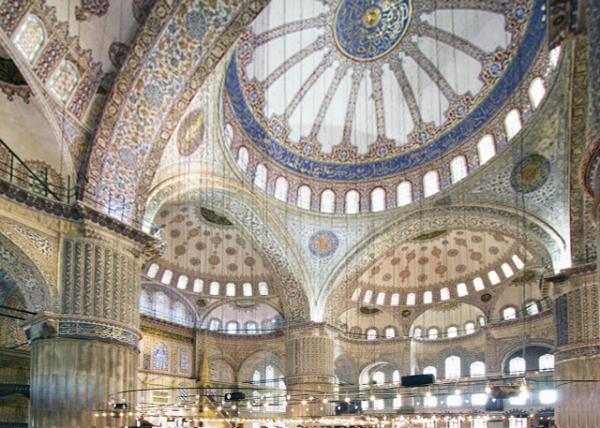 5 Main Domes, 6 Minarets, & 8 Secondary Domes 5 Main Domes, 6 Minarets, & 8 Secondary Domes
(五个主要圆顶,六个宣礼塔和八个次要圆顶) 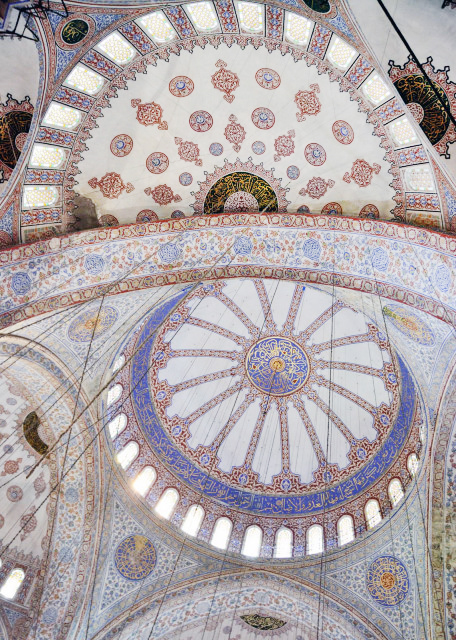
Main Dome & Blue Tiles (主要圆顶和蓝色瓷砖) 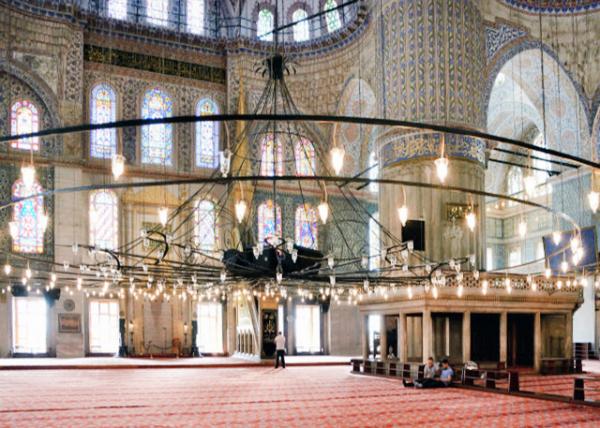 Mihrab (朝拜墙) Mihrab (朝拜墙)
 Prayer Area (祷告区) Prayer Area (祷告区)
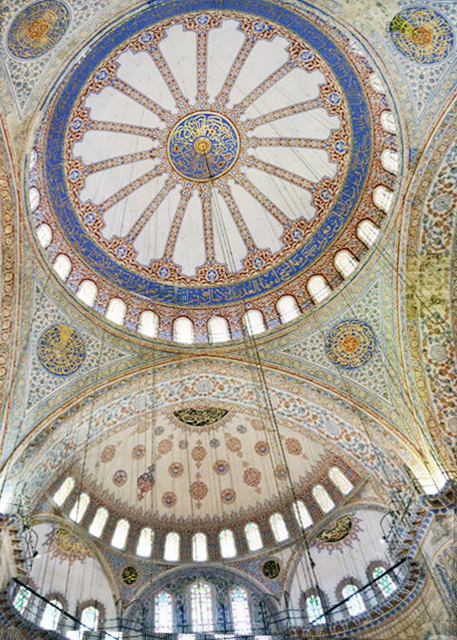
The Upper Area w/ about 20,000 Hand-Painted Glazed Ceramics in 60 Different Tulip Patterns (上部区域装饰大约有20,000种手绘釉瓷和60种郁金香图案) 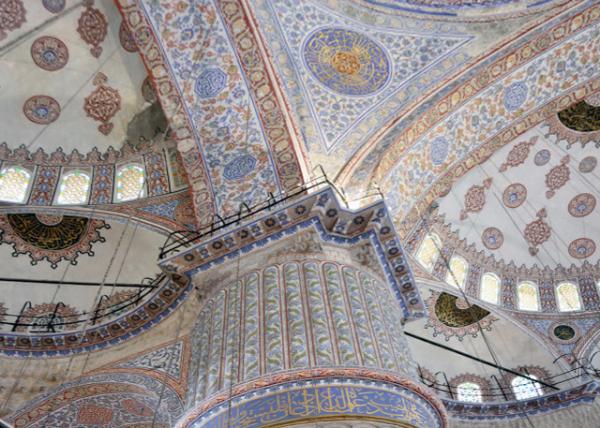 Decorations w/ Verses from the Qur'an Decorations w/ Verses from the Qur'an
(《古兰经》经文装饰) 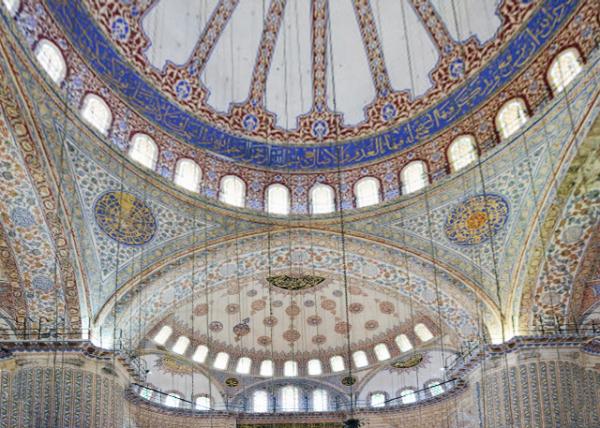 Handmade İznik Style Ceramic Tiles Handmade İznik Style Ceramic Tiles
(伊兹尼克式手工瓷砖)  4 Marble Columns w/ 5 Meters in Diameter 4 Marble Columns w/ 5 Meters in Diameter
(四根直径五米的大理石柱) 
Gateway to the Courtyard (通往庭院的大门) 
Entrance to the Courtyard of Blue Mosque (Sultan Ahmed Mosque), Built between 1609 & 1616, During the Rule of Sultan Ahmet I (蓝色清真寺即苏丹王艾哈迈德“备受赞誉”清真寺庭院入口·建于苏丹王艾哈迈德一世统治时期的1609—1616年间)
Crosslinks(相关博文): Turkey(出游土耳其)
Europe(欧洲掠影) 6th Grade(初中一年级)
|
